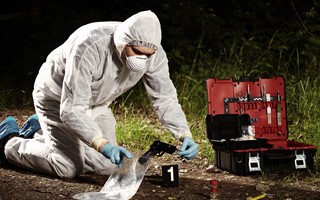News May 13, 2021 5M
Marks and Trace Evidence specialist Sarah Jacob explains why it’s essential to challenge forensic evidence and describes a fascinating case study with an unexpected outcome.
"This case exemplifies why defence examinations are so important. Even a fairly routine check of a footwear mark examination has the potential to flag up additional information which could have a significant bearing on a case.
The situation didn't look good for the defendant. The prosecution had a case against them on the charge of burglary. Shoes recovered from the defendant's home matched the forensic evidence at five separate crime scenes.
With the odds stacked against them, the defence solicitors requested a forensic review of the prosecution's evidence. During this review new information came to the surface. This extra information resulted in a different evaluation of the evidence from the original forensic report. They couldn't have foreseen how useful this procedural review would be. The case against the defendant was dismissed.
This case details how the defence solicitors turned the tide in their favour, leading to the dismissal of the case against their client.
We completed our usual highly detailed examination and the case took an unexpected turn of events when we identified a situation of which the solicitor and the police were previously unaware. This ultimately showed that the evidence against the client did not have any significance within the context of this case".
Background Case Notes
During the investigating of a string of unsolved burglaries, footwear mark evidence was taken from the scene of five properties. Shoes were later recovered from the defendant’s home and compared against the forensic evidence from these five premises.
Before trial the prosecution presented a forensic report stating that there was moderate support for the view that the footwear marks recovered from the five burglaries were made by the shoes of the defendant. The prosecution scientist found a correspondence in pattern, pattern arrangement and general wear, but no fine detail.
Prosecution Findings Challenged
Forensic Access were appointed by the solicitors working for the defence to undertake a standard review of the forensic evidence presented by the prosecution and laid against the defendant.
Our expert was asked to examine the shoes attributed to the defendant and to compare these shoes to the footwear marks recovered from the burgled premises. In so doing this the solicitor requested that our expert establish the strength of any association that may be made between the footwear and the marks.
Forensic Review and Case Result
During the review process we identified statements from an overlooked forensic examination which pre-dated the prosecutions findings.
The statements detailed that footwear marks from three burglaries were previously compared to another pair of shoes of the same pattern type taken from a different suspect. The comparison showed that there was a higher correspondence (including wear and damage) to this pair of shoes. This resulted in extremely strong support for the view that the footwear marks from these three burglaries were made by the shoes from the second suspect. This higher level of association implies that the footwear marks at these three burglaries were not made by the shoes of the defendant.
Our expert noted that footwear marks from the remaining two burglaries had not been compared against shoes of the second suspect. Whether these marks would have yielded a stronger association with these shoes rather than the shoes of the defendant is impossible to say. With this in mind, the evidence against the defendant relating to these two burglaries could be discounted.
This case emphasises the need for routine defence reviews of prosecution forensic findings. In instructing these reviews the process can uncover information that previously wasn’t available. This requires experienced forensic scientists and rigorous quality control.
Forensic Footwear Services: Did you know?
- Footwear Mark Evidence is one of the few evidence types that can provide a conclusive link.
- A shoe is compared against a footwear mark for pattern, pattern arrangement, wear and fine detail, including characteristic damage.
- Even if an item of footwear is linked to a crime scene mark, it may not be possible to say who was wearing the shoe at the time the mark was made.
- It is still possible to compare a shoe seized months after a crime scene mark was recovered. Even if the shoe has been worn there may be enough similar detail for a strong link between the two!
- The strength of the evidence may be limited by the quality of the scene mark. It may only be possible to compare pattern, pattern arrangement and general wear.
- In the absence of a conclusive link where the association is limited to the above, the strength of the evidence will depend on the scientist's interpretation of how rare a shoe pattern and size is.
- In this instance, an examination for the defence team is necessary as a second scientist may have a different view of the commonality of a particular shoe which may change the evidential strength.
To find out more about how our team of world-class scientists can help your defence strategy, please visit our forensic services page or Tel: 01235 774870 to speak a member of our casework team.


